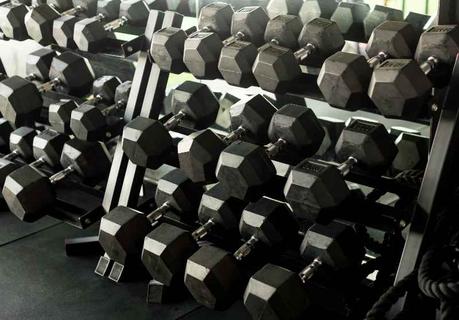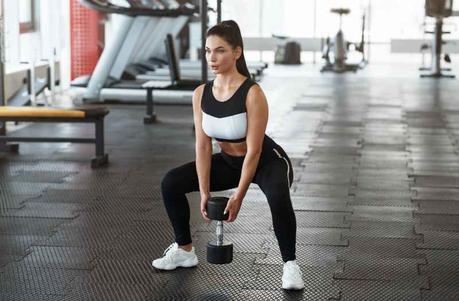Wondering if the dumbbell squat is a good way to train your legs? Here’s a detailed look at the benefits of dumbbell squats and how it’s superior to other squat alternatives.

Squats are—in my opinion—an absolute must for everyone.
Whether you are an athlete, a weekend warrior, or someone who just wants to maintain mobility in their later years, squats are the ticket to opening up your body’s full potential.
Squats help you move better, move faster, and recruit a ton of muscle through the lower and upper body.
But the classic barbell squat isn’t always for everyone at every time.
Whether it’s because you don’t have the upper body mobility to hold onto the barbell properly, lack the equipment, or the bar is simply too heavy for where you are at right now, the barbell squat has its limitations.
Enter the dumbbell squat.
While it may not get as much street cred and attention as barbell squats—you are going be lifting less weight, after all—there are a ton of reasons to incorporate it into your workouts.
In this guide we will look at all of the benefits of dumbbell squats.
We’ll look at muscles worked, some dumbbell squat variations, and answer some of your DB squat-related questions.
Let’s get to squattin’!
Benefits of Dumbbell Squats
The dumbbell squat is a compound exercise that is done with the assistance of two dumbbells.
Whether you grab a pair of rubber hex dumbbells, or pull the neoprene dumbbells off the back of your spin bike, they are an invaluable tool for chasing down your training goals.
The benefits include:
Less equipment required
The squat rack is THE most popular piece of lifting equipment at my local gym.
(Whether people are actually using it for squats is another matter…)
The reality is that barbell squats—and accordingly, the rack required to hold it—is the most popular way to do squats in the gym.
Using dumbbells for squats means that you can skip the line, grab a pair of the best dumbbells for the day’s workout, and find a quiet corner in the gym.
For people who workout at home, and don’t have the luxury or space of having a squat rack, dumbbells are an excellent way to do squats without a squat rack.
(Adjustable dumbbells take the space-saving awesomeness to the next level. Read my review of the best adjustable dumbbells here.)
Dumbbells are a great form of resistance for squats as you can use them just about anywhere and they don’t require all the equipment that rack-based squats need (weight plates, barbell, barbell collar, squat rack, etc).

Dumbbell squats work all the muscles as a barbell squat (and even a little more)
While many of us will struggle will to achieve the same peak power output with dumbbells as we could with a barbell, there is some evidence that at more moderate intensities you are getting all of the same muscle activation.
One paper[1] took a group of ten well-trained young men and had them do squats and lunges with a variety of resistance tools, including a weighted vest, loaded barbell, dumbbells, kettlebell, and the control condition of strictly bodyweight.
Dumbbells led the pack in muscle activation through the quads, edging out barbells and weighted vests (and crushing kettlebells).
Although this is just one study, this should be a big comfort to those who are looking for hypertrophy and general strength development at the gym.
If you are looking to simply build some muscle, dumbbell squats should be one of your top contenders for creating resistance.
Dumbbell squats are easier on the body
One of the reasons I love working with dumbbells, whether it’s doing dumbbell bench press or dumbbell squats, is that it’s generally safer than training with a barbell.
There are a few reasons for this.
First, dumbbells won’t compress the spine the same way a loaded barbell will. Because the weight is at your side, your back isn’t doing the work when descending and popping out of the hole of a squat.
Second, failing a rep with a barbell is also fraught with its own risks, from getting crumpled under the barbell to smashing your garage floor by dropping a barbell full of weight plates.
Dumbbells don’t generate the same kind of sheer and discomfort on the spine and shoulders.
They have shorter to drop, have less combined weight, and don’t “weigh down” the vertebra in your spine.
Dumbbell squats are better for lifters with poor shoulder mobility
I know it seems like I am really kicking the crap out of barbells here, but there is another big benefit to placing the weights in your hands instead of on your shoulders…
When doing barbell squats, your arms are externally rotated in order to keep the barbell in place on the back.
Dumbbell squats are an excellent option for lifters who aren’t able to externally rotate their shoulders to properly hold a barbell during back squats.
While there are some solutions to this, including widening your grip, elevating the barbell, and flaring the elbows, the reality is that not everyone can get their palms under the bar to secure it in place.
Dumbbells provide an alternative to barbell back squats while you work on getting better at being able to externally rotate the shoulders.
Dumbbells are easier to ditch
Dumbbells and machines are my go-to tool for when I am doing a “finisher” set.
(This is where you pick a moderate weight and perform the movement to total failure. Best done at the end of your workout for maximum “pump” and effort.)
The reason is simple: when my muscles are on fire and I can barely lift it any further, I want to be able to fail and ditch the weights safely.
Dumbbells are safer to ditch when your muscles tap out and you want to drop the weights without hurting yourself.
More variations compared to barbell squats
One of the benefits of dumbbell squats are the wide variety of variations you can do with them.
Here are but just a few of them:







There is truly no limit on the variations you can do with dumbbells. Others include lateral squats, Sumo squats, squats with the dumbbells on shoulders, and so on.
Disadvantages of Dumbbell Squats
Alrighty, so now that we’ve spent the last few paragraphs gushing over the dumbbell squat, let’s throw a wet blanket on it with its limitations.
Dumbbell squats have a ceiling in terms of resistance
As you get stronger, and your squat improves in leaps and bounds, so will the amount of weight you can lift.
Dumbbells are harder to scale in this regard, and the amount of weight you can lift is limited by how much you can hold.
Heavier dumbbells are also more bulky and harder to hold beside you.
This is usually a pretty good problem to have—you are getting stronger, after all!—but many lifters find it difficult to squat properly with 120lb dumbbells at their side.
Rounded back syndrome.
While this issue is by no means exclusive to dumbbells, I’ve found that lifters start to get a little careless about weight placement as they get fatigued with dumbbell squats.
The dumbbells begin to drift forward, the lifter leans forward to counterbalance the weight, and the back begins to round.
When using dumbbells for squats, make sure to keep a vertical path on the weights and keep them from swinging forward as you descend.
If you cannot do the movement properly without leaning forward, consider using a couple of small weight plates (5lbs) under your heels as a squat wedge (or invest in a pair of squat shoes) to extend proper range of motion.
Dumbbell Squat — FAQs
Are dumbbell squats effective for building muscle?
Dumbbell squats will help you build muscle in your lower body—particularly the quads—in a way that is safer for many lifters compared to using a barbell.
Because the weight of the dumbbells is lower to the ground, and not being stacked on your spine, dumbbell squats are easier on your back.
As the research above mentioned, you can achieve better levels of muscle activation with dumbbell squats compared to barbell, kettlebell and weighted vest squats.
What muscles do dumbbell squats work?
Dumbbell squats primarily work the four muscles that make up the quadriceps muscle group. They also work the glute and hamstrings to a lesser degree.
There are ways that you can further target the glutes and hamstrings—using split squats, for example—but squats are a knee extension exercise, and the muscles that lead the way on this movement are the quads.
The Bottom Line
With any kind of resistance training, the tools that you use play a huge role in the execution of the movement, from doing it safely to recruiting the right muscles.
No matter what your goals are in the gym, from muscle development to high-performance sport, there are plenty of reasons to add dumbbell squats to your training.
The next time you go workout, grab a pair of dumbbells and get your squat on.
More Squat Guides and Resources
How to Do Split Squats Like a Pro (Plus Benefits, Muscles Worked, and More). The Split Squat is an excellent addition to your lower body workouts. Here’s how to do it like a champion, muscles worked, benefits, and more.
Leg Press vs Squat: Pros, Cons and Differences (and Why You Should Do Both). The leg press and squat are both highly effective at strengthening the lower body. But which is best for you? Here’s a detailed look at both exercises, including benefits and cons.
